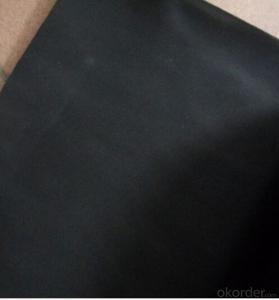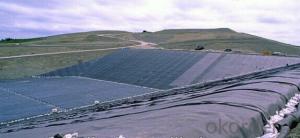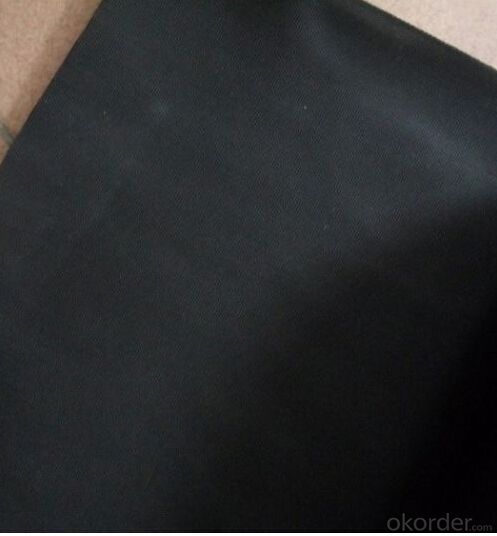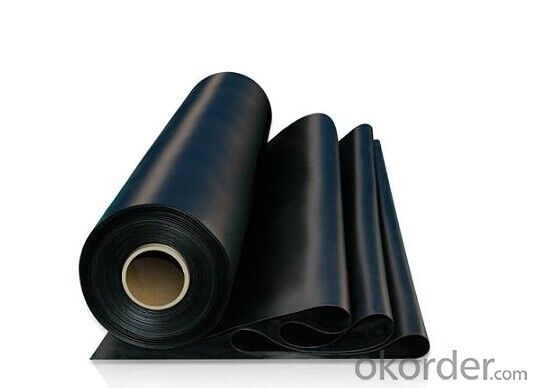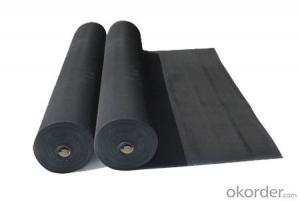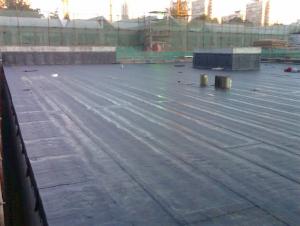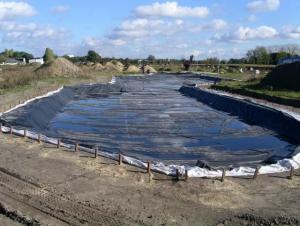Flexible 1M to 4M EPDM Waterproofing Membrane
- Loading Port:
- Qingdao
- Payment Terms:
- TT OR LC
- Min Order Qty:
- 2000 m²
- Supply Capability:
- 100000 m²/month
OKorder Service Pledge
OKorder Financial Service
You Might Also Like
EPDM Waterproof Membrane
1.Product Description
Flexible EPDM Waterproofing Membrane is the modified materials which is widely used at home and abroad in the kinds of roofs, tunnel, basement such sorts of constructions' waterproofing. They are based upon EPDM rubber with modifier, softener and accelerant assistants added to provide flexibility and stability . Through the precise ingredients, mixing, extrusion, rolling, curing processes to made of modified EPDM Waterproofing material with high strength and high flexibility.
2.Features
1. Great tensile strength,long-range elasticity and aging resistant.
2. Excellent heat reisistant and can be used under -70°C~~+110°C .
3.Good anti-corrosion, ultraviolet resistant, root penetration resistance
4.Long life use over 50 years and used longer 100 years or more under the condition of buried in the ground.
5.Light and easy to install.
3.Products Specification
Thickness : 0.3-2.0mm
Width :1m to 4m
Length: 15-100m/roll
Type | EPDM Waterproof Membrane | ||
Material | EPDM Rubber | ||
Thickness | 1.2mm | 1.5mm | 2.0mm |
Weight(kg/m2) | 1.54-1.58 | 1.79-1.83 | 2.25-2.29 |
Size | 1.2m(width) * 20m(length)/roll | ||
Type | Vulcanized & Weldable | ||
Pattern | Non-reinforced(homogeneous) | ||
Packing | 24sqm/roll, with plastic bag | ||
Color | Black | ||
Application | Roof, basement, pond, Lake, steel structure roof, swimming pool, underground, tunnel, etc | ||
4. Product Application:
(1) Roofs, Basement, Toilets
(2) Industrial and civil building waterproofing
(3) Geosynthetic liner for swimming pool, channels, irrigation system
(4) Especially suitable for projects with high requirements in durability, anti-corrosion and deformation

4. Some photos:
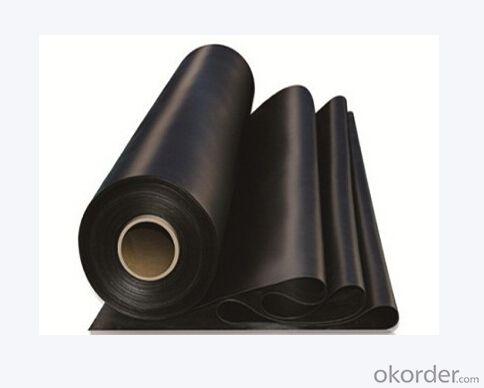


- Q: Can a waterproofing membrane be used in temporary or temporary structures?
- Yes, a waterproofing membrane can be used in temporary or temporary structures. Waterproofing membranes are designed to provide a protective barrier against water penetration, which is essential in preventing moisture damage in any type of building structure. Whether it is a permanent or temporary structure, such as a temporary shelter, tent, or temporary construction site, a waterproofing membrane can be applied to ensure water resistance and protection. It is important to choose a waterproofing membrane that is suitable for the specific needs of the temporary structure and follow proper installation guidelines to ensure its effectiveness.
- Q: Can a waterproofing membrane be used for a roof deck?
- Certainly! A roof deck can indeed utilize a waterproofing membrane. Its purpose is to safeguard against water infiltration, rendering it a perfect resolution for roof decks that face rain, snow, and other atmospheric conditions. Typically, the membrane is administered atop the roof deck surface, constructing an impermeable and long-lasting barrier that thwarts water from permeating the underlying structure. Consequently, this elongates the lifespan of the roof deck while shielding it from possible water harm. Furthermore, certain waterproofing membranes present supplementary advantages, including UV resistance and thermal insulation, thereby amplifying their appropriateness for roof deck usage.
- Q: Can a waterproofing membrane be used on wood surfaces?
- Yes, a waterproofing membrane can be used on wood surfaces. It provides a protective barrier that prevents water from penetrating the wood, thereby prolonging its lifespan and preventing damage from moisture.
- Q: Can a waterproofing membrane be used on flat roofs?
- Yes, a waterproofing membrane can be used on flat roofs. In fact, it is a common and effective method used to protect flat roofs from water damage and leakage. The waterproofing membrane is designed to provide a durable and watertight barrier, ensuring the roof remains protected from rain, snow, and other elements.
- Q: Can a waterproofing membrane be used for tunnels?
- Yes, a waterproofing membrane can be used for tunnels. Tunnels are often exposed to water infiltration due to their underground nature, making waterproofing crucial to prevent water damage and ensure structural integrity. Waterproofing membranes, which are specially designed to provide a barrier against water penetration, can be applied to the tunnel walls, floors, and ceilings to create a waterproof seal. These membranes are typically made of materials such as bitumen, EPDM, PVC, or polyurethane, which are highly resistant to water and can withstand the constant exposure to moisture in tunnels. Additionally, waterproofing membranes can also provide protection against other potential sources of water ingress, such as groundwater or heavy rainfall. Overall, the use of a waterproofing membrane in tunnels is a reliable and effective method to maintain a dry and safe environment within the tunnel structure.
- Q: Can a waterproofing membrane be used on flat roofs?
- Yes, a waterproofing membrane can be used on flat roofs. In fact, it is a common and effective method used to protect flat roofs from water damage and leakage. The waterproofing membrane is designed to provide a durable and watertight barrier, ensuring the roof remains protected from rain, snow, and other elements.
- Q: Can a waterproofing membrane be used on concrete?
- Yes, a waterproofing membrane can be used on concrete. It is a common practice to use waterproofing membranes to protect concrete structures from water damage and moisture penetration. These membranes provide a barrier that prevents water from seeping into the concrete, thereby increasing its durability and lifespan.
- Q: Are waterproofing membranes resistant to alkali exposure?
- Yes, waterproofing membranes are typically resistant to alkali exposure. These membranes are designed to provide a protective barrier against water and other harmful substances, including alkalis. They are made from materials such as rubber, bitumen, or polymer-based compounds that have a high resistance to alkali. This ensures that the membrane remains intact and effective even when exposed to alkali-rich environments, such as concrete or cement surfaces. Additionally, these membranes undergo rigorous testing and are specifically manufactured to withstand alkali exposure, making them a reliable solution for waterproofing applications in various industries, including construction and infrastructure.
- Q: Can a waterproofing membrane be used on roofs?
- Yes, a waterproofing membrane can be used on roofs. Waterproofing membranes are commonly used on flat or low-slope roofs to provide an additional layer of protection against water infiltration. These membranes are typically made from synthetic materials such as modified bitumen, EPDM (ethylene propylene diene monomer), PVC (polyvinyl chloride), or TPO (thermoplastic olefin). They are designed to be durable, flexible, and resistant to UV rays, weathering, and ponding water. When properly installed, a waterproofing membrane can effectively prevent water from seeping into the underlying roof structure, protecting the building from leaks and water damage.
- Q: Can a waterproofing membrane be used for plant rooms or mechanical spaces?
- Yes, a waterproofing membrane can be used for plant rooms or mechanical spaces. These areas often require protection against water damage due to the presence of pipes, equipment, or other mechanical systems. A waterproofing membrane provides an effective barrier to prevent water intrusion and protect the integrity of the space.
Send your message to us
Flexible 1M to 4M EPDM Waterproofing Membrane
- Loading Port:
- Qingdao
- Payment Terms:
- TT OR LC
- Min Order Qty:
- 2000 m²
- Supply Capability:
- 100000 m²/month
OKorder Service Pledge
OKorder Financial Service
Similar products
Hot products
Hot Searches
Related keywords
